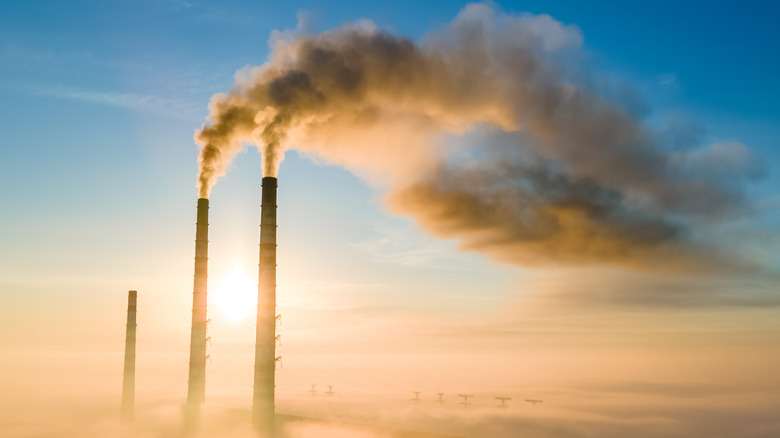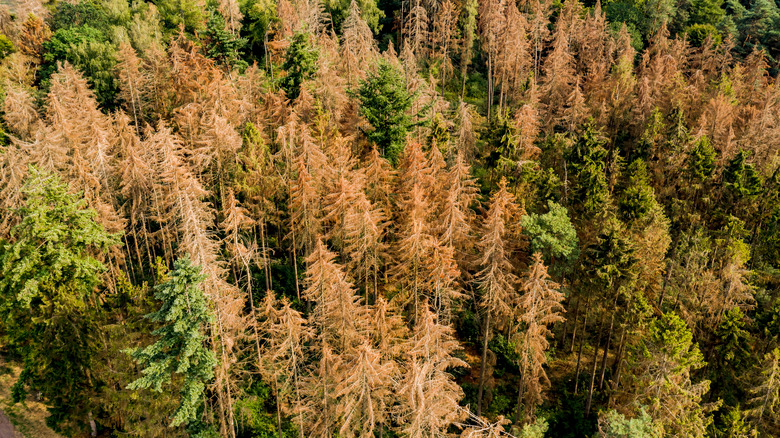What Is Acid Rain And Does It Still Happen?
It can melt statues, kill fish, and devastate forests, but what exactly is acid rain? Acid rain is a term for any type of precipitation that contains acid and falls to the ground, whether as rain, snow, fog, hail, or dust, according to the U.S. Environmental Protection Agency (EPA). Regular rain is already a little bit acidic because the carbon dioxide in the atmosphere mixes with water to form carbonic acid. While conventional rain has a pH of 5.6, acid rain has a pH between 4.2 and 4.4. (The pH scale measures acidity and alkalinity, with a lower pH signifying more acid.)
Acid rain typically consists of either nitric or sulfuric acids. It occurs when sulfur dioxide or nitrogen oxides are released into the atmosphere. These chemicals then react with oxygen, water, and other chemicals to form nitric or sulfuric acid. The acid then combines with water or dust before falling to the ground. If it mixes with water and falls as rain, snow, fog, or hail, this is known as wet deposition. Acids can also directly land on surfaces or interact with chemicals to form larger particles. This is known as dry deposition.
Causes of acid rain
Acid rain is caused whenever sulfur dioxide or nitrogen oxides are released into the atmosphere. This can happen because of natural occurrences like volcanic eruptions or the rotting of vegetables, according to National Geographic. The asteroid that was responsible for the extinction of the dinosaurs 65.5 million years ago also knocked sulfur trioxide into the air and caused a downpour of acid rain, Live Science said.
However, the leading cause of acid rain today is the burning of fossil fuels for human activities. The most common sources of acid rain are gas-powered vehicles, factories, and coal-fired power plants. Fossil-fuel powered electric power plants are responsible for two-thirds of sulfur dioxide emissions and one-fourth of nitrogen oxide emissions, according to the EPA. Oil refineries are another major source of acid rain. Winds can blow the pollutants that cause acid rain for hundreds of miles, according to National Geographic. This means that acid rain doesn't just fall near the source of the pollutants, but is a problem for everyone, the EPA said.
The effects of acid rain are troubling
Acid rain has many harmful effects on the environment. It is especially bad for aquatic ecosystems like lakes, streams, and wetlands, according to the EPA. Acid rain leaches aluminum from the soil, so it increases both the acid and the aluminum content of bodies of water. This is a problem for the fish and other wildlife that live there. Most fish eggs won't hatch when the pH level reaches five. Some acidic lakes have no fish at all.
Acid rain can also harm forests. This is also partly thanks to the aluminum that the acid rain leaches from the soil, which can harm trees and other plants. Further, the rain removes nutrients that trees need from the soil. Acidic fog or clouds at higher elevations can strip trees of their leaves, which weakens them because they are less able to gain energy from the sun. All of this can make trees more vulnerable to insects, disease, and cold temperatures, according to National Geographic. Some soils are better or worse at neutralizing acid that falls as rain. In some regions, like parts of the northeastern U.S., the soil is not able to mitigate the effects of the acid, and the impacts on trees are greater.
Finally, acid rain can damage human-built infrastructure like limestone buildings and cars. It can also react with materials like bronze or marble to dissolve outdoor statues, according to The Washington Post. It can stain metal or create pockmarks in marble.
Acid rain is not a new problem
Acid rain was first discovered and named in 1852 by Scottish chemist Robert Angus Smith, according to Live Science. He observed it in industrial cities in England and Scotland. About 100 years later, scientists began noticing the same phenomenon in the U.S. The main source at the time was coal plants in the Midwest, according to the National Science Foundation. However, the rain was mostly a problem in the northeastern U.S., where it harmed New England sugar maples and polluted lakes in New York's Adirondack Mountains, harming fish and the loons that fed on them. Globally, it was also recognized as a regional problem in Western Europe, according to Live Science.
To control acid rain, the U.S. passed air pollution laws. The Clean Air Act of 1970 was the first to regulate acid emissions. The Clean Air Act of 1990 increased controls, cutting sulfur dioxide emissions by 88% between 1990 and 2017, according to National Geographic. Nitrogen dioxide emissions also fell by 50% during the same time period because of air-quality standards. All of this means that acid rain is less of a problem in the U.S. today, and some forests and fish populations in New England have begun to recover. In Western Europe, stricter environmental laws also reduced the problem, according to The New York Times.
Acid rain today
While acid rain is less of a problem in the U.S. today than it once was, the problem will persist internationally as long as fossil fuels are emitted, according to National Geographic. In southwest China, coal remains a major source of energy, according to Earth and Planetary Science Letters. Because of this, acid rain falls often. Scientists think it may have triggered a deadly landslide on Jiweishan Mountain in 2009 by weakening the shale there. Emissions from China have also caused acid rain to fall in South Korea and Japan, The New York Times reported. While China has begun to control the problem a little bit, it has made about as much progress as the U.S. and Europe had by the 1980s.
Acid rain is also a major problem in India, where sulfur dioxide emissions have increased by 50% since 2007, according to National Geographic. This is threatening the country's iconic Taj Mahal, according to BYJU's. When acid rain falls on the mausoleum, it causes something called marble cancer. This is when the acid dissolves the marble into a powdery substance that then washes away. Authorities have established a 4,000-square mile protective area around the site where emissions are supposed to be controlled, but the building's condition has continued to deteriorate despite this, Independent reported.
The climate connection
While sulfur dioxide and nitrogen oxides are fossil fuels, they are not major contributors to global warming, according to National Geographic. On the contrary, sulfur dioxide has a cooling effect on the atmosphere. However, it turns out that controlling them without reducing fossil fuel emissions overall may not actually solve the acid rain problem. Scientists discovered this by looking at Hubbard Brook in New Hampshire, where acid rain was first documented in North America in the mid-1960s, according to the National Science Foundation.
At Hubbard Brook, scientists monitored the impact of acid rain on the forest, soil, and stream. What they found was that an uptick in atmospheric carbon dioxide was having a similar impact on the area as conventional acid rain. "It appears that these forests and streams are under threat again. Climate change will likely return them to an acidified state. The implications for these environments, and for humans depending on them, are severe," National Science Foundation program director for long-term ecological research Saran Twombly said.





